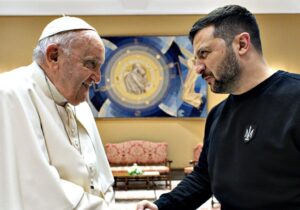The Ongoing Effects of the Crusades on Armenian Christians
In the Armenian Quarter of the Old City of Jerusalem, one finds the Cathedral of St. James, the site where, according to Christian tradition the head of St. James the Apostle, the son of Zebedee, was buried shortly after his martyrdom. One enters the carpeted doorway into one of the most beautiful
hidden gems of the city: blue mosaic walls and extensive candelabras which drape each pillar. Not one square inch is left unadorned, every non-tiled space on the wall is covered by a cracked medieval painting. Much of St. James as it stands today was constructed in the twelfth century, at the height of the Crusader kingdoms under a half-Frankish, half-Armenian queen, Melisende. Despite the eastern interior design of blue ceramics, carpets and massive candelabras which fill the interior space, the Frankish origin of the cathedral’s patroness betrays the choice of Gothic architecture for much of the complex. She ruled the Latin Kingdom at its greatest territorial extent: from the mountains of Lebanon to the Red Sea. The beauty of this cathedral reflects the unique blending of Christian East and West which characterizes the Armenian people and liturgical rite.
Armenians first entered the Levant first as conquerors, at the height of their military and political influence. The greatest of all Armenian kings, Tigranes II the Great, had advanced at least as far as Syria, if not all the way into Judea, and governed a multicultural empire, taking the title, “king of kings”. Unbeknownst to him, Tigranes had begun the two-millennia trajectory to marry Latin and Armenian civilizations, eventually to be consummated with the Christian religion. At the zenith of his power, Tigranes however had backed the losing side in the Mithridatic Wars, and abandoned his conquests to the Romans, then led by Pompey the Great. Armenia grew more and more subordinate to Rome, until it settled as a client kingdom to the Roman Republic. In the fourth century, Gregory the Illuminator baptized the Armenian nation, and within the century, Armenians began their settlement in Jerusalem to lay a claim as the first Christian nation to the Holy City, and continued to call the city their home to this day.
In the fifth century the Council of Chalcedon split the Christian East in two. This division still remains in place today: the Greeks and Latins accepted the Council, while the Armenians rejected it. Even though the Byzantines who ruled the city considered the Armenians heretics and schismatics, their presence in the Holy City remained unchallenged, and the Armenians even managed to secure partitions of the Holy Sepulcher for themselves, one of the most important shrines in the Christian faith.
Six and half centuries after Chalcedon, the Latin Franks established their presence in the Levant during the First Crusade. Pope Urban II called for warriors across western Europe to fight in the Holy Land. The goal was to reclaim lands once held by Christians presently ruled by Muslim powers. The Armenians had chafed under the Seljuk Turkic Empire, but bypassed the Byzantines to ask for assistance directly from the Pope himself. During the First Crusade a broad Christian coalition of Latins, Byzantines and Armenians, fought alongside each other as a unified front against the Turkic warlords who were more concerned with battling each other. The crusading armies had soured their relationship with the Byzantine Emperor Alexios Komnenos after the Latin Crusaders took the recent Christian conquests for themselves. He realized that the Latin and Armenian Crusaders would not return former Byzantine territory, which only worsened the recent schism between Latins and Greeks.
The widening gulf within the Christian coalition did not occur on strictly theological lines. The Latins and Greeks both accepted the Council of Chalcedon, while the Armenians did not. This meant that the Latins and Greeks had a closer theological consensus, from the more divergent Armenians. However, the Latins and Armenian potentates did not factor theological differences into immediate temporal considerations in order to stay united both against the Turkic warlords, and even against the Byzantines who still possessed irredentist goals about reoccupying the Levant. The Byzantine emperor, crusaders and Armenian nobility were statesmen, not theologians: their individual geopolitical situations guided their decision-making more than theological considerations. The priority was given to first expel the Turkic warlords, and then the schisms could be resolved after the fact by the bishops. The Frankish crusaders succeeded in establishing the Latin kingdoms (to the frustration of the Byzantines). The Franks and the local Armenian nobility intermarried, and from these unions came future monarchs like the aforementioned Queen Melisende.
In the present day, one walks down Armenian Patriarchate St. in the Old City on the way to St. James and encounters dozens of informational posters about the Armenian Genocide plastered the walls of almost every building. Many of the families in the Old Quarter trace their lineage back to refugees who escaped the Ottoman persecutions during the First World War to the Vilayet of Palestine. The posters appeal to Jewish sympathies, claiming that the inaction and apathy of the international community after the Armenian Genocide provided the prototype for the Holocaust against the Jews a generation later. The posters further claimed that the lukewarm response to the genocide of the Armenians emboldened Hitler to believe that the world would forget about the Jews in the same way the world forgot about the Armenians. This—along with a Republic of Artsakh flag proudly waving from a windowsill—provides a subtle rebuke of Israel’s recent sale of drones to Azerbaijan. Azerbaijan bought these Israeli drones in their recent war in 2020 against Armenia, fought over the Armenian-majority Nagorno-Karabakh region, which seceded from Azerbaijan and claimed independence as the Republic of Artsakh. Israel receives 40% of its oil imports from Azerbaijan, and Azerbaijan in turn receives 60% of its arms purchases from Israel. Israel has also experienced a rapprochement with Azerbaijan’s ally, Turkey, in recent years, with an eye to use both countries as partners in its rivalry against Iran.
Modern Armenia retains only a shadow of the former glory it enjoyed under monarchs such as Tigranes II and Melisende. The modern nation-state of Armenia retains only a sliver of the original Anatolian homeland, and the nation’s Levantine diaspora feels helpless against the forces of Realpolitik which encourage Israel to overlook threats to the Armenian heartland. Realpolitik brought about the resurgence of Armenian civilization during the Middle Ages, but these same forces now thwart Armenian national ambitions. Armenian nationals and diaspora alike have returned to the mercy of other sympathetic nation-states. The Israeli government still refuses to recognize the Armenian Genocide as part of a strategy to remain on good terms with Baku and Ankara, despite the submission of a bill into the Knesset to do so in November 2021. While other Israeli politicians neglect the recognition of the Armenian Genocide under the justification of a necessary geopolitical step, this miscalculation undermines the State of Israel’s identity as a safe haven in the aftermath of a genocide.






 Sponsor a student for Christianity & National Security 2024
Sponsor a student for Christianity & National Security 2024